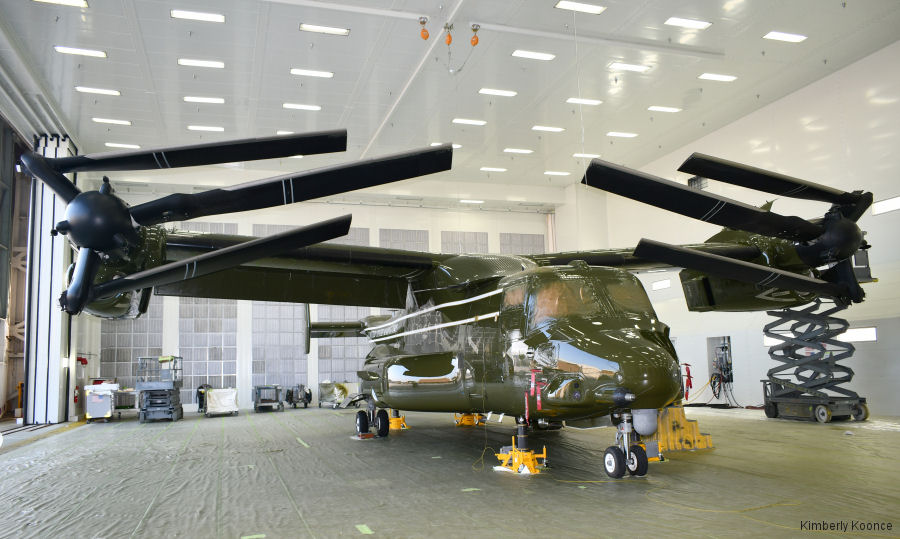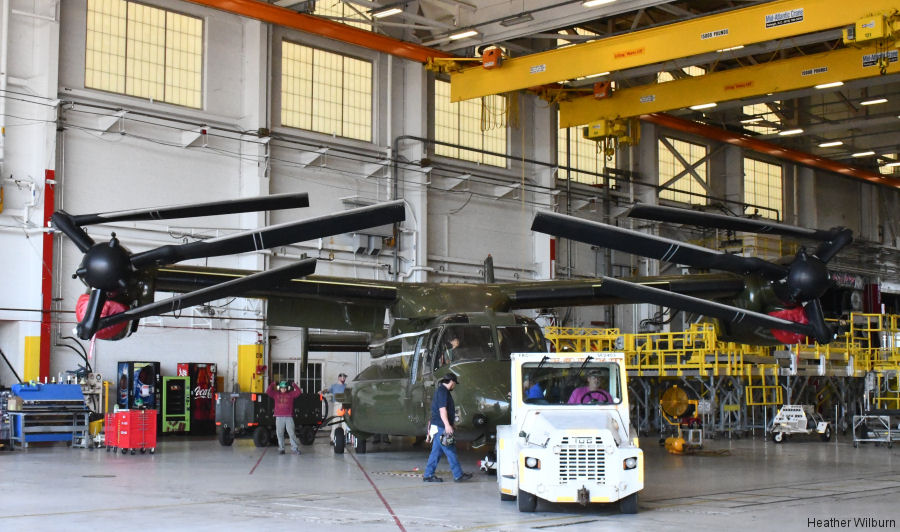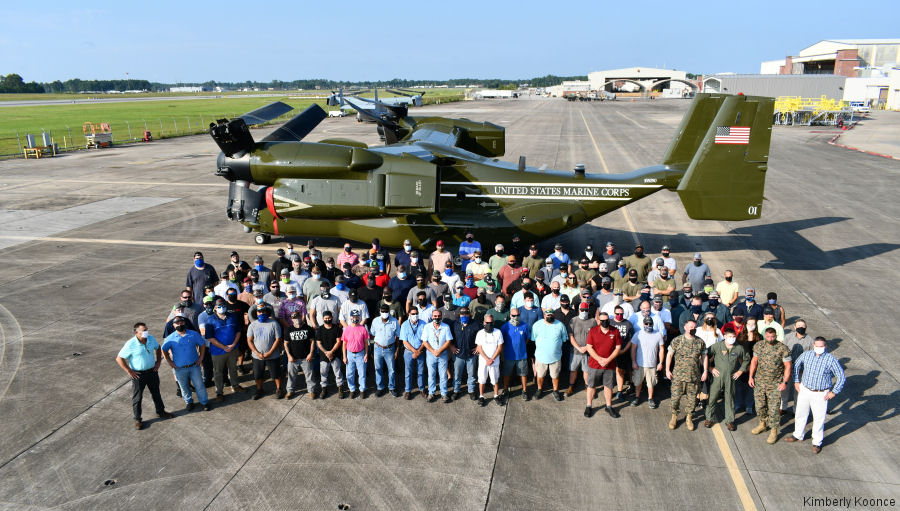
FRCE has conducted modification and Planned Maintenance Interval (PMI) events for Navy and Marine Corps V-22 aircraft since 2009, when the depot inducted its first Osprey.
Now, the facility will provide that same support to Marine Helicopter Squadron 1 (HMX-1). The HMX-1 “Nighthawks” fleet includes a number of “Green Top” MV-22B aircraft, which are all scheduled to receive PMI-2 service at FRCE in the coming months following the successful completion and early return of the first aircraft.
“These HMX-1 V-22s are national assets, performing a very visible and important mission,” said FRCE Commanding Officer Col. Thomas A. Atkinson. “I’m very proud of the V-22 PMI line and our paint shop for a job well done and done so quickly; the aircraft looked really good and we delivered it a month ahead of schedule.”
The new V-22 workload continues FRCE’s long history of service to HMX-1, which is also the primary operational test and evaluation unit for Marine assault support helicopters and related equipment. FRCE first began working with the presidential helicopter in 1967 and, in the past, the depot has serviced CH-46 and CH-53 helicopters for the squadron, as well as the T58-400B engine that powered the presidential VH-3D Sea King and the “White Top” VH-3D itself, also known as Marine One. The VH-92 Fleet Support Team, based at Fleet Readiness Center East, provides engineering and logistics support and assistance for the new VH-92A White Top platform, which is scheduled to serve as the new Marine One.
When FRCE artisans wrapped maintenance on the first HMX-1 Osprey inducted into the facility, the depot beat the requested turnaround time by 28 days – returning the aircraft in just 122 days when the initial goal was set at 150, said Andrew Rock, the depot’s V-22 branch head. The V-22 line was able to move from induction to functional check flight (FCF) within 74 days, which represents a hugely successful effort that played a major role in FRCE beating the turnaround goal, he noted.
“For the aircraft to go from landing for induction to us flying it and having it deemed an FCF aircraft in 74 days is absolutely incredible,” Rock said. “I think this really shows what the team at FRCE is capable of.”
According to Rock, the initial plan was to conduct the HMX-1 Osprey PMI-2 events at Marine Corps Base Quantico, Virginia, which presented several logistical challenges for the V-22 line at FRCE – including the prospect of sending Cherry Point-based artisans to Quantico for an extended period of time. Leaders reached an agreement to send the first V-22 to FRCE with a targeted turnaround time of 150 days; if FRCE could meet this goal, the depot could conduct the required maintenance on the remaining HMX-1 Ospreys at Cherry Point.
“It was a prototype, essentially,” Rock said. “There’s a certain schedule that has to be met. We didn’t initially have an estimate on what the actual turnaround would be, because we had no idea what the aircraft was going to look like when it came in. We didn’t know what we were going to find when we started disassembly for the PMI.”
Planned maintenance interval
A planned maintenance interval is a period of time prescribed for the execution of a maintenance event. In a PMI-1 event, artisans disassemble the aircraft; evaluate its condition; perform required maintenance; update systems; and reassemble the aircraft. PMI-2 events include new paint for the aircraft in addition to the services provided during PMI-1. In both events, the aircraft fly into and out of the facility at FRCE. PMI events comprise the Navy’s Integrated Maintenance Program, which targets the structural integrity of the airframe.
Maintenance and inspection conducted by the squadron at the organizational level (O-level) doesn’t turn up the same issues found at the depot level because O-level maintenance does not, by design, address the same needs.
“A lot of the things we find here at FRCE will only be found during PMI,” Rock explained. “For example, at the squadron level, they’re not going to take out the sponson fuel cells and look at the frames in there. We will do that, and if we pull that sponson fuel cell out and find a bad frame inside, that could add weeks to the turnaround time.”
The HMX-1 aircraft currently in process turned out to be especially “clean,” meaning there were minimal hidden issues, Rock said. That contributed to the remarkable speed with which the team took the V-22 from induction to FCF, a performance he considers a great success. The next V-22 from HMX-1 is already scheduled for induction this fall – with the possibility of moving that induction date up, because the team completed the initial Osprey so far ahead of that initial 150-day goal.
“There was a lot of concern regarding the ability to complete a 150 day turnaround time at FRCE, so it’s good for everybody out there to see us perform,” he said. “We did it, and we did it well, and that’s exactly what the (commanding officer) wants to show.”
The short turnaround from induction to flight check represented a point of pride for Rock and the V-22 artisans at Cherry Point, he said. There’s also the prestige that comes with providing services to the Marines who support the president, he added.
“I’ve said it all before: There’s been a lot of attention on the V-22 line, but really everything that happens is due to the artisans and the support staff,” Rock said. “They have gotten behind every initiative that’s been thrown their way and they have supported it and followed through.
“That shows in the results we’re getting,” he continued. “We have the skills, we have the abilities – and when the logistical elements line up, I believe there’s nothing we can’t do.”
FRCE is North Carolina's largest maintenance, repair, overhaul and technical services provider, with more than 4,000 civilian, military and contract workers. Its annual revenue exceeds $1 billion. The depot provides service to the fleet while functioning as an integral part of the greater U.S. Navy; Naval Air Systems Command; and Commander, Fleet Readiness Centers.


The Fleet Readiness Center East (FRCE) V-22 team poses with the first MV-22B Osprey flown by Marine Helicopter Squadron 1 (HMX-1) inducted for planned maintenance service
See also |
FRCE
HMX-1
MV-22 in
HMX-1 lands Osprey




